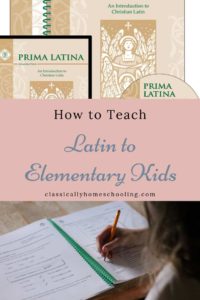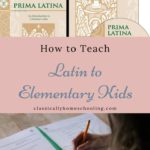How to Teach Latin to Elementary Students
This post may contain affiliate links. For more information, please read my disclosure policy.
Have you wondered how to teach Latin to elementary students?
I received a free copy of Prima Latina from Memoria Press. All opinions are my honest opinions and I was not required to post a positive review.
After all, teaching Latin to high school teens is intimidating enough! But as classical homeschoolers, it’s recommended we teach Latin starting in elementary school. Here’s how!
Take Your Time
Have you ever heard of a principle of classical education called Festina Lente? It’s a Latin phrase that means make haste slowly. And it should be your guiding light as you’re teaching your small children.
Unless everything falls into place quickly and easily, and life rarely allows this to happen, you’re not going to have a little Latin scholar by the age of eleven. But that’s not the goal. The goal is to step foot upon the educational journey called classical education and get started.
You’re not in a race to the finish line. You are preparing your child for life, one drop at a time.
So when you look for a Latin program to use, look for one that makes haste slowly. One that allows your child time to absorb the principles. One that embraces Festina Lente.
Small Bites
Another principle to follow as you’re teaching small kids Latin is that of multa non multum. It’s a principle of much not many.
You don’t want to be throwing hundreds of concepts at your child. Even if you’re planning on crawling through a college-level textbook, elementary children can only handle so many concepts at any given time.
So follow the principle of multa non multum and give your child small bites to chew each week.
Aim for Mastery
It’s vital to aim for mastery with our elementary students. After all, there’s no point in spending hours studying Latin if your child doesn’t learn anything from their lessons.
So give your child small bites to absorb each week. Move at a slow pace, sometimes even a crawl. And aim for mastery. Master the vocabulary. Master grammar.
And don’t move on until your child is confident in their knowledge.
Use a Program Meant for Elementary Students
And the very best way to teach elementary students Latin is to use a program such as Prima Latina that was created specifically to teach Latin to young children.
Good elementary Latin programs are carefully designed to move slowly and only give kids small bites of information to absorb at any time.
They allow elementary children to master Latin.
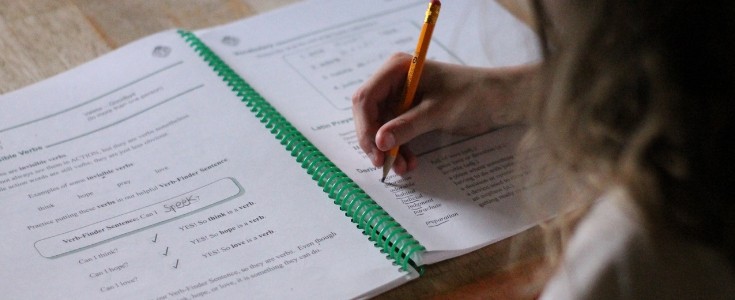
Introducing Prima Latina from Memoria Press
A couple of years ago, my fourth child began First Form Latin. It was amazing! After years of struggle, he finally thrived with Latin. Last year he completed Second Form Latin and this year he’s working through Third Form Latin. The series has worked wonderfully for him!
And I knew that I wanted my youngest children to use the same Latin series.
First Form Latin isn’t truly the beginning of Memoria Press’ Latin curriculum. Before the Form Latin series is Latina Christiana. And before Latina Christiana is Prima Latina.
Prima Latina is aimed at kids in the first through third grades who are competent readers.
Perfect! My little girl is starting the third grade and is a competent reader. I want her to have a gentle, slow start to Latin. And that’s just what Prima Latina offers!
Before we go farther, here’s what Prima Latina covers:
- Seven parts of speech
- 125 Latin vocabulary words
- Numbers 1-10
- Basic Constellations
- Simple introduction to
- Tenses
- Derivatives
- Conjugations
- Declensions
As you can tell, Prima Latina stays true to the principles for how to teach Latin to elementary students. Children learn Latin in small bites allowing them to master each lesson before moving on. And the pace is slow. I’m able to learn Latin just by helping my child through her lessons. And she’s happily studying little bites of Latin each day.
The 25 lessons introduce a new grammar skill, which is perfect for young kids. Latin reinforces my child’s English grammar!
There’s a practical Latin phrase. A couple of the phrases we’ve covered so far are salve/salvete and magistra/magister. So my child can now greet me by saying, “Salve magistra!”
Each lesson also includes 5 vocabulary words, which is perfect for young kids who are easily frustrated.
Prima Latina also introduces the English derivatives of the Latin vocabulary. For instance, my daughter learned the Latin word laboro means I labor in English. And then we studied the English words laboratory and labor.
I love using our Latin studies to expand my children’s English vocabulary!
And finally, the lesson includes one line of a prayer. By the end of the chapter, the children know the entire prayer. It’s a good pace.
The Prima Latina Curriculum Includes:
Student Book – As you might guess from the title, the student book is for your child. It includes the lesson and exercises for each lesson. The exercises take up two pages and include review questions, lesson questions, practice translating, practice speaking, vocabulary reinforcement, and fun practice.
Teacher Manual – The teacher manual is almost identical to the student book. The page numbers align so we can both open to page 14 and read lesson two together. However, the teacher manual includes the answers to the exercises rather than space for you to write the answers yourself.
In addition, the teacher manual includes general teaching guidelines at the back of the book. You’re given a sample lesson plan, a reproducible vocabulary drill sheet, and a reproducible grammar drill sheet. You’ll also find the reproducible tests and test keys at the very back of the teacher manual.
Instructional DVDs – The DVDs feature Leigh Lowe, the author of Prima Latina, teaching each lesson to the children. I love, love, love, the DVDs Memoria Press offers. The teachers include tips and explanations that are not found in the books.
Pronunciation Guide, Songs, & Prayers – This is a CD that includes the pronunciation guide, prayers, and lessons in Prima Latina. And you don’t need to listen to the CD only during lessons. You can also listen to it in the car, over lunch, or during quiet time.
Flashcards – The flashcards are actually from Latina Christiana. My daughter loves having flashcards to drill her vocabulary words. And I’ve found flashcards work well!
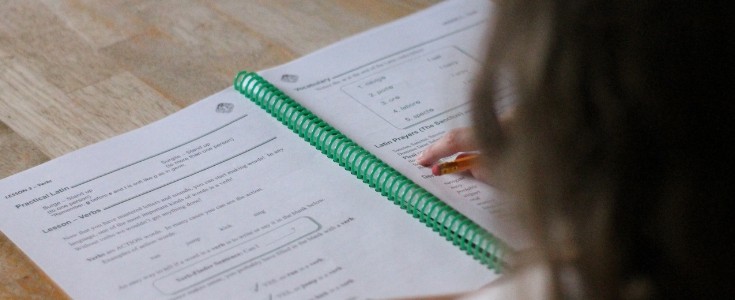
Using Prima Latina in the Home
My 3rd-grade daughter started Prima Latina at the beginning of August. She was so excited to finally start Latin just like her big brother! So on the first day of school, we put the instructional DVD into the DVD player and got started.
Leigh Lowe is a delightful teacher. We started by learning how to pronounce the Latin alphabet as well as the differences between the Latin alphabet and the English alphabet.
I thought I could look off my daughter’s student book while we listened to the lecture. No, she grabbed her book and her pencil and made it clear it was HER Latin book to use. I’m so thankful the teacher manual has the exact same information down to the page number! I’m able to use my book while my daughter studies from her Latin text.
The Flashcards
While I received the Latina Christiana flashcards to use with Prima Latina, I didn’t pull them out immediately. Latina Christina introduces vocabulary in a different order from Prima Latina. It seemed like a pain in the neck to search through a pile of flashcards for the specific cards we needed.
After a few weeks, it became apparent we needed the flashcards. Reciting the vocabulary out of the book never leads to full mastery. Flashcards do.
I pulled out the flashcards so my daughter and I can drill with them.
Her mastery of the Latin vocabulary skyrocketed after that!
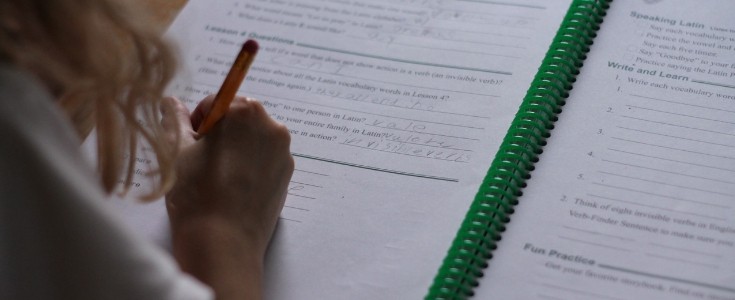
Workbook Exercises
There are two pages of workbook exercises in each lesson. And they have an awesome variety! We switch from reviewing previous lessons, to answering questions about the current lesson. Then there’s a bit of translation, speaking practice, and more vocabulary work.
And Latin is teaching wonderful study skills. She’s learning to do a quick review before working on each day’s lessons.
We both love Prima Latina.
But remember the principles of teaching elementary kids Latin: make haste slowly, much not many, and work for master? That came into play here.
After a couple of weeks, we realized she needed to slow down to savor the lessons. Allow more time to master the vocabulary. And absorb Latin in tiny bites.
So I decided to slow my daughter down and cover Prima Latina over two years instead of one.
I’ve seen this happen before with her older siblings. Often the kids request to slow down for a period of time until they get their feet underneath them. And then they ask to pick up the pace!
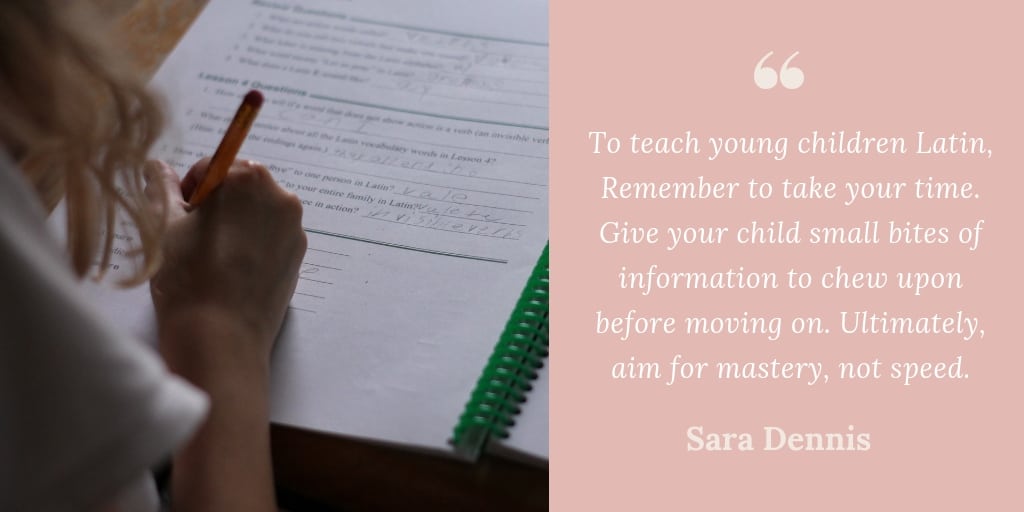
Our Schedule
Week One
- Monday – We watch the DVD lesson together.
- Tuesday – Review flashcards and prayer. Complete the review questions.
- Wednesday – Review flashcards and prayer. Complete the lesson questions.
- Thursday – Review flashcards and prayer. Complete the translation exercise.
Week Two
- Monday – Review flashcards and prayer. Complete the Speaking Latin exercise.
- Tuesday – Review flashcards and prayer. Complete Write and Learn #1.
- Wednesday – Review flashcards and prayer. Complete Write and Learn #2.
- Thursday – Review flashcards and prayer. Complete Fun Practice.
As I mentioned it’s likely that she’ll ask to speed up in a couple of weeks once she has her feet under her. However, even if she doesn’t I’m happy moving at this pace.
She adores her studies. She’s learning Latin in small bites, moving slowly, and mastering each lesson.
And at this rate, she’ll be ready for First Form Latin by the seventh grade!
To answer the question from before, how to teach Latin to elementary students, you need to follow the principles of classical education.
Take your time.
Give your child small bites of information to chew upon before moving on.
Aim for mastery, not speed.
And use Prima Latina from Memoria Press. It will gently guide you and your child toward Latin mastery!
Share your best tips for how to teach Latin to elementary students in the comments below!
